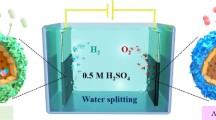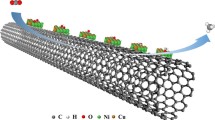Abstract
The design of high-performance and low-cost catalysts for mild electrocatalytic nitrogen reduction reaction (NRR) is particularly desirable and remains greatly challenging due to the unfavorably low ammonia yield rate and Faradaic efficiency (FE), which comes from the difficulty in making nitrogen activation superior to competitive hydrogen evolution reaction (HER). Herein, we report a well-designed two-dimensional nanosheet-like Fe-tetrapyridophenazine (Fe-TPPHZ) catalyst for ambient NRR process, which was facially prepared by coordinating Fe ions with TPPHZ ligand. The Fe-TPPHZ catalyst shows a remarkable NRR activity at ambient conditions with a high NH3 yield rate of 29.07 µg h−1 mg−1 and an outstanding FE of 11.5% at − 0.3 V vs. RHE. An ammonia yield rate of 21.86 µg h−1 mg−1 is observed after 100 consecutive cycles, with a retention rate of 75.2%. This work will provide a rational design idea to use non-precious metal-based complex as highly effective electrocatalysts for NRR test.
Graphical Abstract
A two-dimensional nanosheet-like Fe-tetrapyridophenazine (Fe-TPPHZ) catalyst was successfully designed and utilized for ambient NRR process, showing a remarkable NRR activity with a high NH3 yield rate of 29.07 μg h−1 mg−1, outstanding FE of 11.5% at − 0.3 V vs. RHE and good retention rate of 75.2% after 100 cycles.










Similar content being viewed by others
References
Liu Q, Xu T, Luo Y, Kong Q, Li T, Lu S, Alshehri AA, Alzahrani KA, Sun X (2021) Recent advances in strategies for highly selective electrocatalytic N2 reduction toward ambient NH3 synthesis. Curr Opin Electrochem 29:100766–100772
Tang C, Qiao S-Z (2019) How to explore ambient electrocatalytic nitrogen reduction reliably and insightfully. Chem Soc Rev 48:3166–3180
Duan G, Chen Y, Tang Y, Gasem KAM, Wan Ding PD, Fan M (2020) Advances in electrocatalytic ammonia synthesis under mild conditions. Prog Energ Combust 81:100860–100889
Xu T, Liang J, Li S, Xu Z, Yue L, Li T, Luo Y, Liu Q, Shi X, Asiri A, Yang M, Sun C X (2021) Recent advances in nonprecious metal oxides electrocatalysts and photocatalysts for N2 reduction reaction under ambient condition. Small Sci 1:2000069–2000086
Zhu X, Mou S, Peng Q, Liu Q, Luo Y, Chen G, Gao S, Sun X (2020) Aqueous electrocatalytic N2 reduction for ambient NH3 synthesis: recent advances in catalysts developing and performances boosting. J Mater Chem A 8:1545–1556
Shi L, Yin Y, Wang S, Sun H (2020) Rational catalyst design for N2 reduction under ambient conditions: strategies toward enhanced conversion efficiency. ACS Catal 10:6870–6899
Cui X, Tang C, Zhang Q (2018) A review of electrocatalytic reduction of dinitrogen to ammonia under ambient conditions. Adv Energy Mater 8:1800369–1800393
Kordali V, Kyriacou G, Lambrou C (2000) Electrochemical synthesis of ammonia at atmospheric pressure and low temperature in a solid polymer electrolyte cell. Chem Commun 17:1673–1674
Kugler K, Luhn M, Schramm JA, Rahimib K, Wessling M (2015) Galvanic deposition of Rh and Ru on randomly structured Ti felts for the electrochemical NH3 synthesis. Phys Chem It Phys 17:3768–3782
Zhang J, Zhao B, Liang W, Zhou G, Liang Z, Wang Y, Qu J, Sun Y, Jiang L (2020) Three-phase electrolysis by gold nanoparticle on hydrophobic interface for enhanced electrochemical nitrogen reduction reaction. Adv Sci 7:20022630–20022636
Lv J, Tian Z, Dai K, Ye Y, Liang C (2019) Interface and defect engineer of titanium dioxide supported palladium or platinum for tuning the activity and selectivity of electrocatalytic nitrogen reduction reaction. J Colloid Interf Sci 553:126–135
Hu L, Khaniya A, Wang J, Chen G, Kaden WE, Feng X (2018) Ambient electrochemical ammonia synthesis with high selectivity on Fe/Fe oxide catalyst. ACS Catal 8:9312–9319
Li G, Pan Z, Lin H, An L (2021) In-situ formation of bismuth nanoparticles on nickel foam for ambient ammonia synthesis via electrocatalytic nitrogen reduction. J Alloy Compd 875:160006–160013
Zhang L, Ji X, Ren X, Ma Y, Shi X, Tian Z, Asiri AM, Chen L, Tang B, Sun X (2018) Electrochemical ammonia synthesis via nitrogen reduction reaction on a MoS2 catalyst: theoretical and experimental studies. Adv Mater 30:1800191–1800196
Yang X, Nash J, Anibal J, Dunwell M, Kattel S, Stavitski E, Attenkofer K, Chen J, Yan Y, Xu B (2018) Mechanistic insights into electrochemical nitrogen reduction reaction on vanadium nitride nanoparticles. J Am Chem Soc 140:13387–13391
Zhao Z, Long Y, Luo S, Luo Y, Chen M, Ma J (2021) Metal-free C3N4 with plentiful nitrogen vacancy and increased specific surface area for electrocatalytic nitrogen reduction. J Energy Chem 60:546–555
Yu X, Han P, Wei Z, Huang L, Gu Z, Peng S, Ma J, Zheng G (2018) Boron-doped graphene for electrocatalytic N2 reduction. Joule 2:1610–1622
Wang Y, Zhang C, Li X, Gao T, Wang X-B (2021) Metal-free carbon-based nanomaterials for electrochemical nitrogen and carbon dioxide reductions. Mater Res Bull 140:111294–111308
Qiu W, Xie X-Y, Qiu J, Fang W-H, Liang R, Ren X, Ji X, Cui G, Asiri AM, Cui G, Tang B, Sun X (2018) High-performance artificial nitrogen fixation at ambient conditions using a metal-free electrocatalyst. Nat Commun 9:3485–3492
Zhang L, Ding L-X, Chen G-F, Yang X, Wang H (2019) Ammonia synthesis under ambient conditions: selective electroreduction of dinitrogen to ammonia on black phosphorus nanosheets. Angew Chem Int Ed 58:2612–2616
Guo Y, Cheng Y, Li Q, Chu K (2021) FeTe2 as an earth-abundant metal telluride catalyst for electrocatalytic nitrogen fixation. J Energy Chem 56:259–263
Yang X, Sun S, Meng L, Li K, Mukherjee S, Chen X, Lv J, Liang S, Zang H-Y, Yan L-K, Wu G (2021) Molecular single iron site catalysts for electrochemical nitrogen fixation under ambient conditions. Appl Catal B: Environ 285:119794–119802
Liu P-Y, Shi K, Chen W-Z, Gao R, Liu Z-L, Hao H, Wang Y-Q (2021) Enhanced electrocatalytic nitrogen reduction reaction performance by interfacial engineering of MOF-based sulfides FeNi2S4/NiS hetero-interface. Appl Catal B: Environ 287:119956–119964
Li Y, Li J, Huang J, Chen J, Kong Y, Yang B, Li Z, Lei L, Chai G, Wen Z, Dai L, Hou Y (2021) Boosting electroreduction kinetics of nitrogen to ammonia via tuning electron distribution of single-atomic iron sites. Angew Chem Int Ed 60:9078–9085
Liu W, Han L, Wang H-T, Zhao X, Boscoboinik JA, Liu X, Pao C-W, Sun J, Zhuo L, Luo J, Ren J, Pong W-F, Xin H (2020) FeMo sub-nanoclusters/single atoms for neutral ammonia electrosynthesis. Nano Energy 77:105078–105085
Wang M, Liu S, Qian T, Liu J, Zhou J, Ji H, Xiong J, Zhong J, Yan C (2019) Over 56.55% faradaic efficiency of ambient ammonia synthesis enabled by positively shifting the reaction potential. Nat Commun 10:341–348
Sahoo SK, Heske J, Antonietti M, Qin Q, Oschatz M, Kühne TD (2020) Electrochemical N2 reduction to ammonia using single Au/Fe atoms supported on nitrogen-doped porous carbon. ACS Appl Energy Mater 3:10061–10069
Wang Z, Zheng K, Liu S, Dai Z, Xu Y, Li X, Wang H, Wang L (2019) Electrocatalytic nitrogen reduction to ammonia by Fe2O3 nanorod array on carbon cloth. ACS Sustain Chem Eng 7:11754–11759
Zhang D, Liu Y, Mao B, Li H, Jiang T, Zhang D, Dong W, Shi W (2021) Double-phase heterostructure within Fe-doped Cu2 – xS quantum dots with boosted electrocatalytic nitrogen reduction. ACS Sustain Chem Eng 9:2844–2853
Li XF, Li QK, Cheng J, Liu L, Yan Q, Wu Y, Zhang X-H, Wang Z-Y, Qiu Q, Luo Y (2016) Conversion of dinitrogen to ammonia by FeN3–embedded graphene. J Am Chem Soc 138:8706–8709
Han B, Meng H, Li F, Zhao J (2020) Fe3 cluster anchored on the C2N monolayer for efficient electrochemical nitrogen fixation. Catalysts 10:974–982
Ma Z, Xiao C, Cui Z, Du W, Li Q, Sa R, Sun C (2021) Defective Fe3GeTe2 monolayer as a promising electrocatalyst for spontaneous nitrogen reduction reaction. J Mater Chem A 9:6945–6954
Lv X-W, Liu X-L, Suo Y-J, Liu Y-P, Yuan Z-Y (2021) Identifying the dominant role of pyridinic-N – Mo bonding in synergistic electrocatalysis for ambient nitrogen reduction. ACS Nano 15:12109–12118
Yang Z, Yuan C-Z, Xu A-W (2018) Rationally designed Fe-tetrapyridophenazine complex: a promising precursor to single-atom Fe catalyst for efficient oxygen reduction reaction in high-power Zn-air cells. Nanoscale 10:16145–16152
Zhang Z, Yao K, Cong L, Yu Z, Qu L, Huang W (2020) Facile synthesis of a Ru-dispersed N-doped carbon framework catalyst for electrochemical nitrogen reduction. Catal Sci Technol 10:1336–1342
Zhao Y, Li F, Li W, Li Y, Liu C, Zhao Z, Shan Y, Ji Y, Sun L (2021) Identification of M-NH2-NH2 intermediate and rate determing step for nitrogen reduction with bioinspired sulfur-bonded FeW catalyst. Angew Chem Int Ed 60:20331–20341
Watt GW, Chrisp JD (1952) A spectrophotometric method for the determination of hydrazine. Anal Chem 24:2006–2008
Li L, Tang C, Xia B, Jin H, Zheng Y, Qiao S-Z (2019) Two-dimensional mosaic bismuth nanosheets for highly selective ambient electrocatalytic nitrogen reduction. ACS Catal 9:2902–2908
Mukherjee S, Cullen DA, Karakalos S, Liu K, Zhang H, Zhao S, Xu H, More KL, Wang G, Wu G (2018) Metal-organic framework-derived nitrogen-doped highly disordered carbon for electrochemical ammonia synthesis using N2 and H2O in alkaline electrolytes. Nano Energy 48:217–226
Zhao D, Sun K, Cheong W-C, Zheng L, Zhang C, Liu S, Cao X, Wu K, Pan Y, Zhuang Z, Hu B, Wang D, Peng Q, Chen C, Li Y (2020) Synergistically interactive pyridinic-N-MoP sites: identified active centers for enhanced hydrogen evolution in alkaline solution. Angew Chem 132:9067–9075
Xia L, Fu W, Zhuang P, Cao Y, Chee MOL, Dong P, Ye M, Shen J (2020) Engineering abundant edge sites of bismuth nanosheets toward superior ambient electrocatalytic nitrogen reduction via topotactic transformation. ACS Sustain Chem Eng 8:2735–2741
Alper K, Tekin K, Karagöz S, Ragauskas AJ (2020) Sustainable energy and fuels from biomass: a review focusing on hydrothermal biomass processing. Sustain Energ Fuels 4:4390–4414
Acknowledgements
This work was financially supported by the National Natural Science Foundation of China (21773018 and 21975033) and the Analysis and Testing Center, NERC Biomass of Changzhou University.
Author information
Authors and Affiliations
Corresponding authors
Additional information
Publisher’s note
Springer Nature remains neutral with regard to jurisdictional claims in published maps and institutional affiliations.
Supplementary Information
Below is the link to the electronic supplementary material.
Rights and permissions
About this article
Cite this article
Wang, Y., Luo, H., Ye, C. et al. Two-dimensional Fe-TPPHZ nanosheets for electrohydrogenation of N2 to NH3 under ambient conditions. J Appl Electrochem 52, 1295–1304 (2022). https://doi.org/10.1007/s10800-022-01712-y
Received:
Accepted:
Published:
Issue Date:
DOI: https://doi.org/10.1007/s10800-022-01712-y




